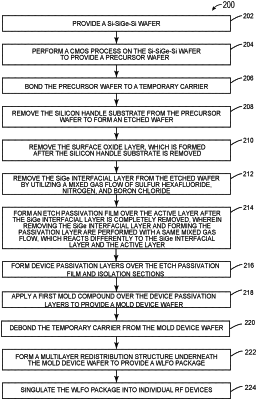| CPC H01L 21/76256 (2013.01) [H01L 21/31116 (2013.01); H01L 21/76254 (2013.01); H01L 23/66 (2013.01); H01L 2223/6616 (2013.01)] | 20 Claims |

|
1. A method comprising:
providing a precursor wafer having a plurality of device regions, wherein:
each of the plurality of device regions includes an active layer that is fabricated from doped epitaxial silicon;
an interfacial layer formed of silicon germanium (SiGe) is directly over the active layer of each of the plurality of device regions; and
a silicon handle substrate is directly over each interfacial layer;
removing the silicon handle substrate completely;
removing the interfacial layer completely to expose the active layer; and
forming an etch passivation film directly over the active layer of each of the plurality of device regions, wherein:
both removing the interfacial layer and forming the etch passivation film utilize a same reactive chemistry combination;
the reactive chemistry combination is a mixed gas flow of sulfur hexafluoride (SF6), nitrogen (N2), and boron chloride (BCl3), which reacts differently to the interfacial layer and the active layer, and provides reactive radicals fluorine (F), chlorine (Cl), boron nitride (BN), and boron chloride (BClx);
the reactive chemistry combination is capable of producing a variable net performance, which is an etching performance of the interfacial layer or a forming performance of the etch passivation film over the active layer; and
the F and Cl radicals are capable of etching doped epitaxial silicon and SiGe, and the BN and BClx radicals are capable of forming a passivation material on doped epitaxial silicon and SiGe, wherein a competition between an etching rate of the F and Cl radicals and a forming rate of the BN and BClx radicals determines the net performance.
|